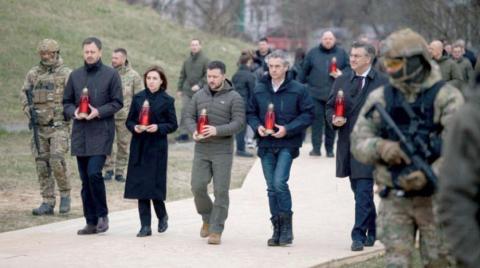
The scars of war cover the neighborhoods of the Syrian city of Aleppo.
Its Old City, once described as an “Eden” by poet and philosopher Abou Alaa Al-Maari and the “Asian Athens” by France’s La Martine, is no more.
The regime forces and allied militias transformed what was once a charming and enchanting city into a pile of rubble, which is all that remains of its ancient heritage.
Asharq Al-Awsat toured the city, which has been invaded by the stench of death and rendered unrecognizable after years of war.
The regime seized control of eastern Aleppo in 2012, but it did not allow life there to return to normal. It instead struck it with barrel bombs and missiles, imposing a stifling siege that led in late 2016 to the forced displacement of its residents and opposition.
On the sides of the road leading to the Old City’s iconic citadel, one can see the damage the bombardment has caused on the ruins. All but one building that lined the road remains. The rubble from the destroyed houses has not been removed, impeding traffic and erasing what is left of the city’s alleys that once reflected its rich heritage under various rulers throughout history.
Locals told Asharq Al-Awsat that the markets were not completely destroyed during the battles between the regime and opposition. They were instead destroyed by the regime after the opposition’s withdrawal in order to cover up for their own looting.
A local researcher said that the regime’s destruction of Aleppo surpassed that caused by invading Hittites, Mitannis, Assyrians, Babylonians, Persians, Greeks and Romans throughout history.
The regime does not seem to care about Aleppo’s heritage and history, he told Asharq Al-Awsat.
The regime’s boasting of its indifference is reflected in its hanging of a large poster of its leader Bashar Assad over the citadel’s gate.
Pedestrians were few in the region. The majority of stores were shut. Only a cafe, with a handful of customers, was open. The area, which was once a tourist hub, has been transformed into a ghost town.
An elderly man in his 70s was on the verge of tears when asked about how Aleppo has been sadly transformed.
The alleys surrounding the Old City, even though they bear fewer signs of destruction, are just as empty. Services there are non-existent, which is demonstrated by the piling up of waste on the sides of the roads and the lack of streetlamps.
Passing through the area, one cannot ignore the nearly three-meter high sand barriers that have been placed by the regime. They have been put there to prevent passersby from witnessing their looting of nearby stores and houses.
The scene is different in western Aleppo, which has remained under regime control and where some one million people live.
Life there appears normal. Public services are available everywhere and parties and shows thrown by the wealthy locals have not been interrupted by the fighting. Regime officers and security forces, as well as major store owners and “war merchants”, appear to be living in another world far removed from the ravages witnessed in eastern Aleppo.












